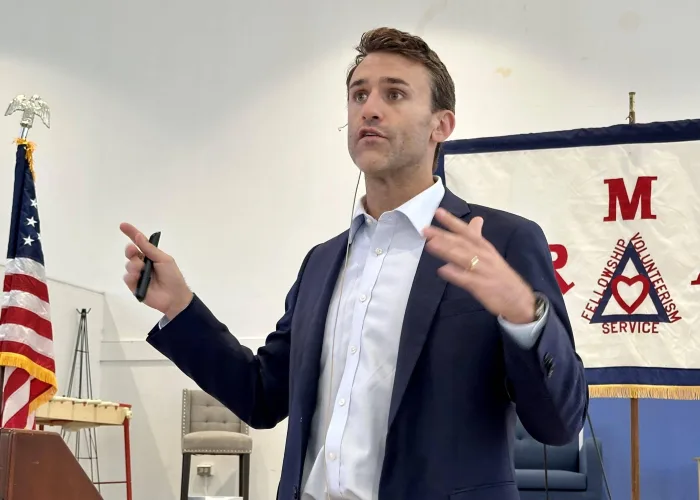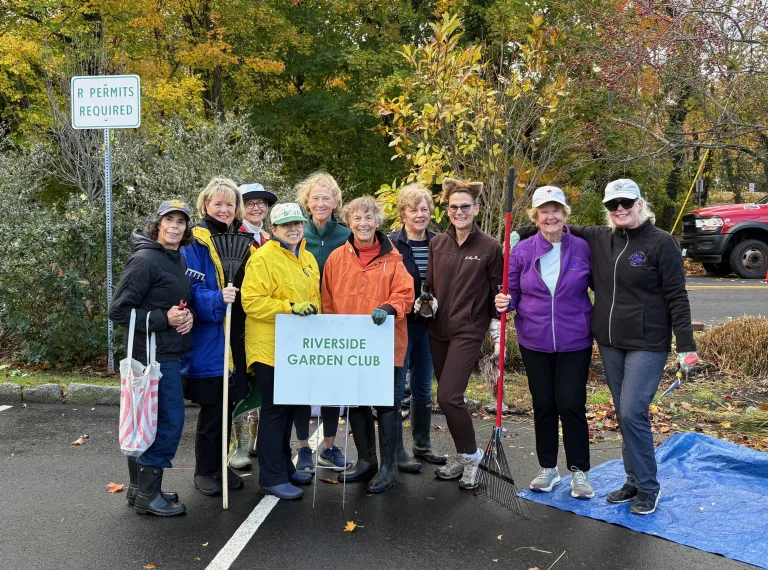
By Rick Donohue
At the October 1 meeting of the Retired Men’s Association hosted by Peter Berg, Nick Simmons, a graduate of Yale and Harvard, detailed his unique perspective on Connecticut’s economic revival. Simmons, who served in both the Biden administration and for three nonconsecutive years in the administration of Connecticut Governor Ned Lamont, offered a candid retrospective on the state’s struggles and its strategic pivot. Now the CEO of Pursuit, an organization focused on training thousands of individuals for technology jobs, Simmons’s current work remains deeply intertwined with the economic future he helped shape.
Simmons recalled that when Governor Lamont took office, the state was facing a crisis driven by the “lost decade” of the 2010s, a term coined by Connecticut reporter and columnist Dan Haar. Unlike neighboring Massachusetts and New York, which experienced significant economic growth, Connecticut’s economy actually shrank by half a percentage point. This stagnation was deeply linked to a population decline and the state’s dire fiscal condition, which was the second worst in the nation, trailing only Illinois. The state’s previous governor, Dannel P. Malloy, left office with an approval rating in the low 20s, underscoring the political mandate for Governor Lamont to “save Connecticut.”
The economic challenges, Simmons argued, were not simply about taxes, citing the departure of GE to Boston— a city with higher taxes and costs—as proof that businesses sought innovation superhubs. Ninety percent of U.S. economic growth during that period was concentrated in these hubs, such as New York City and Boston, which boasted industry clusters, R&D from universities, and robust workforce pipelines. Connecticut lacked a top 100 city to compete. Furthermore, poor infrastructure plagued the state, including I-95’s stretch from Greenwich to Norwalk, recognized as the most congested highway in America, and a strategically misplaced flagship university, UConn, which was located far from major economic centers.
Simmons explained that the Lamont administration’s core five-part plan focused on fiscal discipline, workforce reform, being business-friendly, investing in innovative cities, and attracting young families. Crucially, they tackled the budgetary woes by adhering to fiscal guardrails, leading to eight credit rating upgrades and paying off $10 billion in pension debt. Simmons highlighted the creation of the Office of Workforce Strategy (OWS) and the public-private entity, AdvanceCT, chaired by figures like former Pepsi CEO Indra Nooyi, designed to coordinate training with business needs and serve as a business concierge service.
Physical revitalization became a dramatic symbol of the new strategy. Simmons shared that he was directly involved in the effort to transition valuable waterfront real estate, noting the investment required to clean up and demolish industrial sites. He recalled watching a 70-acre coal plant in Bridgeport, the last operating one in New England, being blown up at 3 a.m. to clear the way for housing, retail, and office space. Additionally, the state committed to leveraging New Haven’s assets— particularly Yale—by investing millions into lab space to build a life sciences hub.
Simmons affirmed that Governor Lamont’s work paid off, noting that the state is now “holding its own” in GDP growth compared to the rest of New England and the United States. The pandemic also accelerated the influx of younger families, leading to population booms in key age groups (30-40 yearolds), though major challenges persist.
These continuing hurdles include skyrocketing housing costs (Connecticut is the second-worst state for building new housing) and crushing energy expenses. Moreover, Simmons warned that federal policy shifts could threaten state progress. He stated that cuts to Biden administration programs—which focused on infrastructure, clean energy, and cleaning up industrial sites—were “incredibly damaging to our growth prospects.” For instance, Congressman Jim Himes secured $50 million for a seawall in Bridgeport to protect a redevelopment area from flooding, but that funding was later stripped away.
Connecting his former government policy work to his current role, Simmons emphasized that the greatest future challenge is preparing the workforce for Artificial Intelligence (AI). He noted that 66% of business leaders stated they would not hire someone without AI skills, yet only 4% of the population is properly skilled. At Pursuit, Simmons explained, they no longer teach traditional coding languages like Python, but rather new tools like ChatGPT, Gemini, and Cursor, helping low-income individuals fill emerging roles in marketing, accounting, and data management that are being complemented by AI. This focus on rapidly building AI skills, he asserted, is a “make-or-break moment for the rest of the decade” for Connecticut.
The RMA’s next presentation, “Don’t Wear Leggings on an Airplane and Other Lessons from Unhappy Landings,” by Christine Negroni, is scheduled for 11 AM on Wednesday, October 15, 2025. RMA presentations are held at Christ Church Greenwich, Parish Hall, 254 E. Putnam Avenue, Greenwich, CT 06830.
This 30-minute presentation is a humorous and empowering look at the tremendous advances in aviation safety over the years, explaining how we arrived at a time when the vast majority of air accidents are survivable. Aviation got to this stellar level of safety through intentional effort. From enhanced communication to checklists to pre- and post-flight briefings, these flying lessons can be applied throughout our personal and professional lives.
Christine Negroni has the distinction of working in three often reviled fields. For most of her career she has been a journalist, or an “enemy of the American people,” as one U.S. President characterizes the profession. And for eight years she worked for lawyers as chief of investigations for air accidents and aviation-related terrorism. Then there was the time she got close to government work while serving on an FAA advisory committee planning new rules for airlines.
She began her career as a television correspondent and worked at CBS, CNN, and ABC where she still participates as a “talking head” during coverage of air disasters. She writes about the aviation industry for The New York Times, the Washington Post, Travel + Leisure, and Slate, among others.
Her book, “The Crash Detectives,” is a New York Times bestseller. Her previous book, “Deadly Departure,” was a New York Times Notable Book. She is presently writing her third book, a memoir titled “Don’t Wear Leggings on an Airplane – and Other Lessons From Unhappy Landings.”
During the Obama administration she was interviewed for a White House nomination to the National Transportation Safety Board. And though she does not claim to have worked in politics, she cannot rule out entering a 4th odious profession in the future.
To stream the presentation by Christine Negroni at 11 AM on Wednesday, October 15, click on https://bit.ly/30IBj21. This presentation will also be available on local public access TV channels, Verizon FIOS channel 24 and Optimum channel 79.
Note: The views expressed in these presentations are those of the speakers. They are not intended to represent the views of the RMA or its members.
RMA speaker presentations are presented as a community service at no cost to in-person or Zoom attendees, regardless of gender. Any member of the public who would like to receive a weekly email announcement of future speakers should send a request to members@greenwichrma.org. The RMA urges all eligible individuals to consider becoming a member of our great organization, and thereby enjoy all the available fellowship, volunteer, and community service opportunities which the RMA offers to its members. For further information, go to https://greenwichrma.org/, or contact info@greenwichrma.org.




